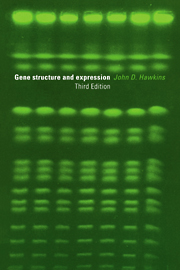Book contents
- Frontmatter
- Contents
- Introduction to the third edition
- Introduction to the second edition
- Introduction to the first edition
- List of abbreviations
- 1 Deoxyribonucleic acid (DNA)
- 2 Ribonucleic acid (RNA)
- 3 Methodology
- 4 Prokaryotic DNA replication and gene expression
- 5 The operon concept
- 6 Eukaryotic gene organisation and replication
- 7 Eukaryotic transcription
- 8 Post-transcriptional processing of RNA
- 9 Oncogenes
- 10 Haemoglobin
- 11 Proteins of the immune system
- 12 Some gene families
- 13 Mitochondrial and chloroplast genomes
- 14 Different and evolving genomes
- Glossary
- Reading lists
- Index
5 - The operon concept
Published online by Cambridge University Press: 05 June 2012
- Frontmatter
- Contents
- Introduction to the third edition
- Introduction to the second edition
- Introduction to the first edition
- List of abbreviations
- 1 Deoxyribonucleic acid (DNA)
- 2 Ribonucleic acid (RNA)
- 3 Methodology
- 4 Prokaryotic DNA replication and gene expression
- 5 The operon concept
- 6 Eukaryotic gene organisation and replication
- 7 Eukaryotic transcription
- 8 Post-transcriptional processing of RNA
- 9 Oncogenes
- 10 Haemoglobin
- 11 Proteins of the immune system
- 12 Some gene families
- 13 Mitochondrial and chloroplast genomes
- 14 Different and evolving genomes
- Glossary
- Reading lists
- Index
Summary
Genes for sets of metabolically related enzymes are transcribed as one long message
In bacteria, genes specifying enzymes that are all part of a metabolic pathway are commonly transcribed as single units from adjacent lengths of DNA with only short non-coding stretches between them. Such ‘super-genes’ are known as operons and give rise to polycistronic mRNAs. Since translation immediately follows transcription this results in the rapid production of a set of functionally related enzymes in equivalent amounts – a process known as co-ordinate control. Some of these operons and the enzymes they encode are constitutive, being synthesised more or less constantly; others are subject to precise control, signalled by the presence or absence of metabolites in the cell and are called either inducible or repressible depending on whether they are switched on or off by a particular metabolite.
There are two classes of genes – structural genes encode information for either stable RNAs or mRNAs; regulatory genes regulate the transcription of structural genes but are not themselves transcribed. These regulatory genes are situated immediately upstream from the operon whose activity they control. In addition to the promoter there is another region, known as the operator which is either directly adjacent to the promoter, or even overlaps it.
Negatively controlled inducible operons are not normally transcribed because a specific repressor protein is bound to the operator. Induction occurs when an inducer – a small molecule – binds to the repressor, altering its conformation so that it now dissociates from the operator and allows transcription to proceed.
- Type
- Chapter
- Information
- Gene Structure and Expression , pp. 70 - 85Publisher: Cambridge University PressPrint publication year: 1996



